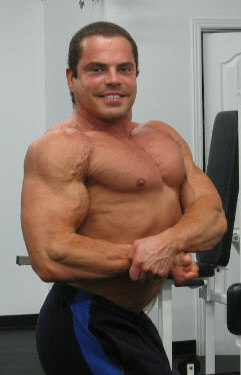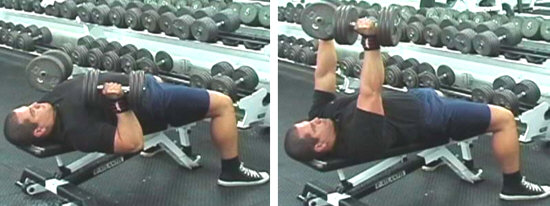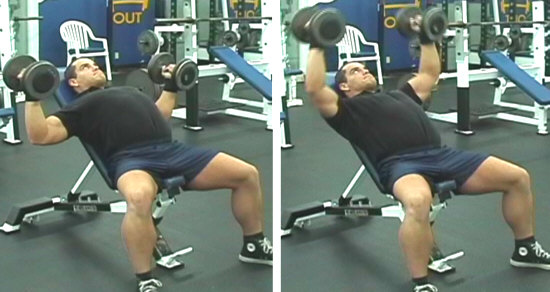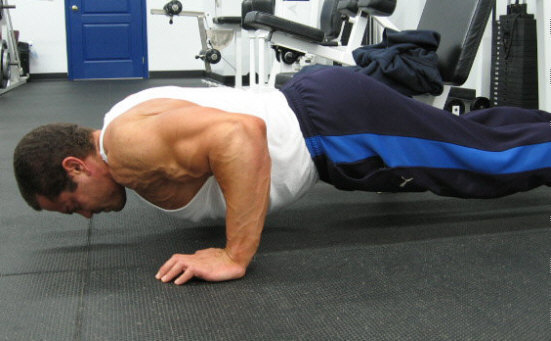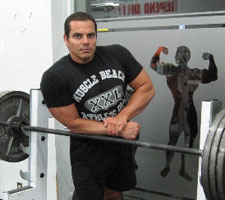
Total Fitness Bodybuilding Videos Customized Diet and Training Programs |
Start With A Mass Building Compound Exercise My personal favorite chest mass building compound exercise is the dumbbell bench press. This exercise has all the muscle building benefits of the regular barbell bench press, but it has some other unique muscle building advantages as well. Dumbbells allow you to work through a more natural range of motion. You are not locked into a fixed position as you are when holding a barbell. This generally places less strain on the wrists, elbows, and shoulder joints. Dumbbells also force both the left and right sides of the body to handle an equal workload and thus develop both sides of the chest equally. When you use a barbell or machines your stronger side can actually compensate for your weaker side and perform more of the lifting. And because you have to stabilize and balance 2 dumbbells, instead of just 1 barbell, there is a higher level of nero-muscular activation. Youíll recruit more of the small stabilizer muscles to help balance and support the weights. Most people will feel a deeper level of muscular fatigue after doing an all out set of dumbbell bench presses compared to doing an all out set of barbell bench presses.
Dumbbell Bench Press
To get in position for the dumbbell bench press set the dumbbells down in front of the bench about a foot apart. Bend your legs and squat down as if you were doing a dumbbell deadlift, stand up and then hold the ends of the dumbbells against the front of your thighs. Sit back onto the end of the bench with the dumbbells resting on your thighs. Keeping your body in this position, let yourself slowly fall back onto the bench so that the dumbbells are resting against your chest. And then securely position your feet flat on the floor.
This may seem simple and easy to do when using light-weights. But when you get to the point of using dumbbells where the combined weight is equal to or greater then your bodyweight, then getting in position to do the exercise is a lot more difficult and proper set up technique is critical.
Fully Stretched Exercise Doing exercises where you work the muscles through a full range of motion and experience a good stretch in the bottom of the lift are incredibly effective for maximizing your muscle growth. In the case of chest training nothing works better here then the dumbbell flye. When I do dumbbell flyes I purposely use light to moderate weights, higher reps, and really emphasize the stretch at the bottom. Rather then trying to lift heavy, I simply focus my attention on doing dynamic stretching with weights. Stretching exercises, like dumbbell flyes, help to stretch the connective tissue which surrounds the muscles, and there by expand the fascia and enable the muscles to grow bigger and stronger. The ideal time to perform fully stretched exercises is right after youíve trained a particular bodypart with a big basic compound movement and the muscles are ďpumped upĒ and feeling tight. At this stage the connective tissues are already being stretched from the blood volume in the muscles, and then by doing full range of motion stretching with weights you will really stretch the fascia and increase the muscle growth potential. My personal favorite variation is the incline dumbbell flyes performed on a 45 degree angle bench. This really stretches out the upper chest and I find the angle doesnít place as much stress on my shoulder joints.
Incline Dumbbell Flyes
When doing dumbbell flyes, start off really light, Iíll start off with just 20 lb. dumbbells and work up to only 50ís at most, and Iím an experienced bodybuilder. The weight is not important here. The main thing is feeling the deep stretch and working the muscles through a full range of motion. If you go too heavy youíll not be able to stretch as deep and youíll risk pulling or tearing a muscle.
Hold the bottom position for a second or two to really emphasis the stretch, and then only bring your arms half way up before lowering them down to the bottom position again. DO NOT lift your arms all the way to the top where the dumbbells touch, as this just takes the tension off the chest muscles.
Peak Contraction Exercise Peak contraction exercises are basically the opposite of fully stretched exercises. The majority of the tension is in the muscles is at the top of the movement when muscles are fully contracted. And there is less tension at the beginning and mid-range of the exercise. In the case of chest training, exercises like pec-deck flyes and cable crossovers work the chest hardest in the full contracted position. You have to strain to keep the handles together at the completion of the movement, you canít lock out the weight at the top and get a little break like you can with bench presses. After completing a heavy mass building compound mid-range exercise like the bench press, then doing a fully stretched exercise like the dumbbell flye, finishing up with a peaked contraction exercise like the cable cross over will really work the entire chest through a full range of motion. Again heavy weights are not critical here. The main thing is squeezing and flexing the chest muscles. Hold the peak contracted position for 1-2 seconds at the top of each rep. Donít worry about the stretch with this exercise, just focus your attention on the top half of the lift and pumping as much blood as possible into your chest muscles.
Cable Cross Overs
The Final Pump Up... If you have anything left in the tank after completing the previous 3 exercises then you can finish off your chest workout with high rep push ups. Push ups are one of my favorite chest exercises of all time. Before I got involved with bodybuilding I was training in martial arts and got quite good at doing high rep push ups. At my peak I could pump out 100 push ups in a single set. I honestly feel that all the push ups that I did while training in martial arts really helped give my chest development a head start and is part of the reason why my chest is one of my best body parts today. Push ups are quite simple, just hit the floor and pump them out. I shoot for 100 total reps at the completion of my chest workouts. Basically, Iíll do a set for as many reps as I can, rest a minute, do another set, rest a minute, etc. until Iíve completed 100 total reps.
Push Ups
After youíve done 100 push ups at the completion of your chest workout your pecs will feel so pumped and tight that youíll think they are going to burst.
Re-Cap Of The Workout Here is just a final re-cap of the entire mass building chest workout:
Start with a mass building mid-range compound exercise: Warm up with light-weights and pyramid up in weight each set until you get to your top work set weight. Use a top weight that allows you to complete between 5-10 reps per set. This is your compound power movement so do 3 heavy sets.
Perform a fully stretched exercise: Warm up with really light-weights and stretch out the muscles. Gradually increase the weights, but donít go too heavy. Focus on stretching the muscles, not moving big weights. Work up to 2-3 sets of 12-15 reps.
Finish off with a peak contraction exercise: Do 1-2 warm up sets and then jump to a working weight that allows you to complete 2-3 sets of 12-15 reps. Focus on squeezing and flexing the muscles with each rep rather then moving big weights.
Optional Exercise:
Well, there you have it... a complete muscle pumping chest workout that will help pack on slabs of new muscle growth to your pecs.

"Blast Your Bench" The Internet's #1 Bench Press Program Since 1997... 
|
